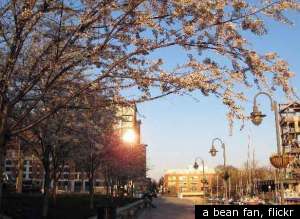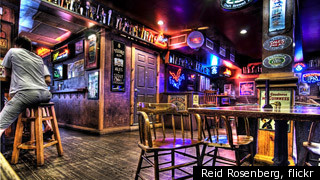
As I hopped into the cab that would take me to the airport, I felt optimistic that my weekend getaway would be an exciting one. Within seconds, the driver began making small talk.
"Where you traveling to?" he asked with considerable enthusiasm despite the redeye hour.
"Baltimore," I said with an equal amount of pluck.
"Oh, I'm sorry," said the driver...
At that moment I was reminded that the East Coast city of Baltimore is still considered by some travelers not worthy of a visit. When I pressed my taxi driver for his reasoning, he gruffly responded that it doesn't compare to nearby Washington D.C.
And here was yet another reminder: Baltimore often gets caught in the crossfire of comparison between its more popular neighbors, for better or for worse. At the core of these comparisons is typically the question of identity. What makes "Baltimore" Baltimore?
Baltimore City Paper's Martin L. Johnson addressed this issue indirectly in 2010, with his story about Visit Baltimore's somewhat controversial "Happy Place" tourist campaign. Johnson mentioned Baltimore's "transition from a post-industrial hollow" into "a more cohesive, fully redeveloped city."
"And just as the city itself appears on its way to being redeveloped," said Johnson, "the city's brand is becoming uncertain."
Baltimore's Revitalization
As I spent my weekend touring various parts of the city and talking with long-time locals and veteran business owners, I soon discovered that Baltimore is quite the paradox when it comes to its identity or "brand." To be sure, the city's roots are planted firmly in the fishing and shipping industries, with the tobacco and sugar industries also playing historic roles. In the early seventeenth century manufacturing became prevalent, providing valuable jobs to people until the mid- to late-twentieth century. By the end of the 1970s, Baltimore fell into disrepair, and the city and its harbor were in need of revitalization – especially if it wanted to lure people back to the downtown region. Considerable revitalization has occurred since then, with a slow shift from manufacturing to a more service-based culture.
 Harbor East
Harbor East
If my experience in Baltimore was truly indicative of the city's recent changes, then the city has certainly grown into a new pair of shoes over the past few decades. From the shiny William Donald Schaefer Building built in 1992 to the ongoing renovations in the Harbor East area, the city's facelift is multi-faceted. Among those facets is Baltimore's important restaurant and bar scene.
Perez Klebahn, general manager of Mr. Rain's Fun House, a unique and contemporary restaurant and bar in Federal Hill, understands the cultural impact restaurants and bars can have on a community. "I think food and drink is pertinent to the identity of any city and its culture," said Klebahn. "[But] for Baltimore to truly revitalize its market and culture, it needs to accept diversity."
"I think Baltimore is headed in the right direction, although it has to be very careful that it finds an identity to match its roots."
The Roots of a Food Scene
Across the harbor in the Fells Point neighborhood, I dropped by the Pierpoint to sample the fare of owner Chef Nancy Longo. As a life-long citizen of Baltimore and a chef with over 18 years of experience, Longo is adamant about the importance of the city's gastronomical roots to its shifting identity.
Longo believes that while Baltimore is a "few years behind" other food scenes on the East Coast, there are advantages to not already having a fixed image in peoples' minds. "That also means we co-exist with our old food and new," said Longo. The mingling of old with new is evident in Pierpont creations like Eastern Shore rabbit sausage and Maryland rockfish dumplings. In fact, Longo has done her fair share of studying crab cakes, terrapin soup, and other Maryland cuisine, calling it "confused" due its British and French influences from both the northern and southern regions of the country.
Yet despite this confusion, she stresses that any mixing of regional cuisine with modern creativity should stay true to its origins. "The old needs to be preserved because the old is what got us here in the first place," said Longo.
This testament is pervasive throughout Fells Point and Federal Hill. One need not look farther than these neighborhoods' historic buildings and long-term businesses to see a blending of the old with the new. It's difficult to comprehend that these areas – now entwined with Baltimore's renaissance – were almost torn down by city government.
 Max's Taphouse
Max's Taphouse
"It's all quite ironic since Fells Point was to be demolished in 1966 to make way for a highway," noted Ron Furman, proprietor of Max's Taphouse.
The I-95 expansion plans inevitably were dropped after citizens banded together in 1967 to form The Preservation Society. Decades later these neighborhoods are now vital components of Baltimore's revitalization, boasting one of the highest densities of restaurants and bars on the East Coast. Leading the charge are businesses like Max's Taphouse and Brick Oven Pizza, which have both been around for over 25 years.
Furman noted that Fells Point and other Baltimore neighborhoods are starting to show signs of that same diversity Mr. Rain's Perez Klebahn says Baltimore needs to accept. "I've been in Fells Point for over 25 years," said Furman, "and seen great changes. In the 70s and 80s Fells Point would have been considered quite bohemian. Today you have neighborhood taverns along with five-star restaurants."
"Best of all there are no chains, so each place has its own unique character which is something you won't find [often] these days," he added.
The Local Food Trend
One trend that stood out when speaking to Baltimore's restaurant and bar owners was the strong desire to use locally-grown ingredients, often organic. And while many will scoff at this trend as merely a gimmick to draw in more customers, I sensed a sincere determination in the voices of the city's proprietors. Everywhere I went there was a sense of commitment to the neighborhood, often taking the form of finding and buying from local growers at farmers' markets, co-ops, and local gardens. Demand is growing, and there is momentum to renovate and expand existing local markets like the historic Broadway Market in Fells Point.
"I think the real untold story here is about the farms in Maryland, ones that are producing produce [and] meat for us organically," said Longo.
 Broadway Market
Broadway Market
Longo told me that farmers' markets are spread out so that many neighborhoods can benefit from them. Even Baltimore's new food czar Holly Freishtat has promoted greater access to fresh foods in Baltimore's neighborhoods.
"A study of Baltimore neighborhoods found that nearly a fifth of its 630,000 residents live with little or no access to fresh foods," the AP's Ben Nuckols grimly reported last July. This acts as a reminder that access to fresh local food goes beyond the Baltimore food scene.
In a sense, the food scene is subtly shaping the identity of Baltimore by promoting the expansion of local food and markets. Yet that identity might prove to be unmarketable, much to the chagrin of Baltimore's tourist industry. Only time will tell what the transformation of the Charm City will bring.